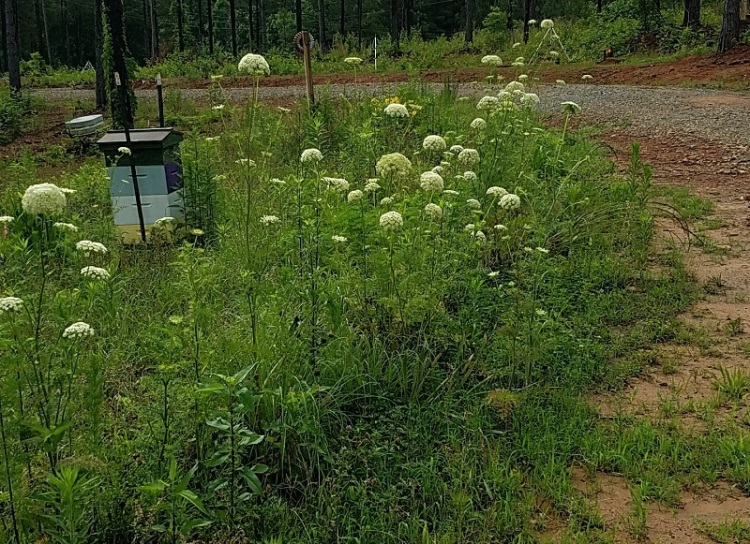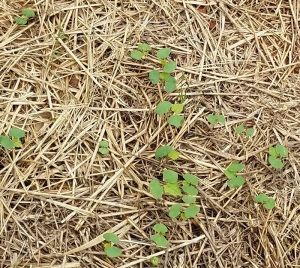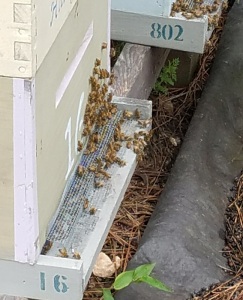
A couple of years ago, we had an erosion problem along the driveway and I had some left-over seed packets, so I sowed carrots, cabbage, and who-knows-what-else in front of the “garden” where the English hive resides. I’d read that both carrots and cabbage produce nectar sources at times when nectar is scare, and I figured that the carrot tubers would have to break up the cement-like clay at least a little. Well, now the carrots are blooming, and it’s a wonderful sight, especially with a large variety of pollinators visiting.
According to The World Carrot Museum, carrots are biennial and require a cold snap to produce seeds in their second year. Well, the extended period of below-freezing temperatures certainly seems to have done a good job with that this year. Some of the flower stalks are at chest height and there is an abundance of blooms.
HoneyBeeSuite says that carrot honey has an aroma reminiscent of chocolate, and what could be better than honey and chocolate? I doubt that we have enough plants to really be able to taste that, but it’s certainly an incentive to plant more carrots that we don’t intend to harvest for food.

Buckwheat honey, on the other hand, has an earthy flavor that people either seem to love or hate. Again, I doubt that we have enough buckwheat planted to really get an idea of what true buckwheat honey tastes like, but we do have two areas of buckwheat growing that will provide nectar a month apart from each other. I’ll continue to sow at intervals to help the bees through the nectar dearth that we all know is coming. The bloom time on the fall crop we planted last October was only a couple of weeks, but the bees were all over it while it lasted. My hope is that it will self-seed enough to keep a nectar supply going. Its self-seeding habit can become a problem if it’s planted where it’s unwanted, but it’s also a great crop to till under before it seeds to improve soil quality, if that’s what you want. It seemed like the perfect solution for the area that will eventually become a garden and orchard, but for now just needs something growing to slow down water run-off.

Hubby is currently inspecting hives, but a quick look yesterday showed that all are thriving. He took 80 large frames with him, so between those and all the medium frames we already have at the farm, he can continue to provide room for growth for the next couple of weeks. Me — I’m home sniffing and sneezing. Allergies or a cold? Who knows, but I was too muddled-headed to drive to the farm last night. With Tropical Storm Alberto on the way, staying home and maybe packing some more boxes doesn’t feel so bad, although I hate to miss a long weekend at the farm.
Hubby had to drive down early to meet the mobile home representative to make sure we can get our new small-home onto the lot and discuss whether we need to remove any trees to get it into the space currently occupied by the RV. We weren’t expecting the new home for 8 – 10 weeks as we had to custom order one with a propane stove and furnace, but we could have it as soon as in 3 – 4 weeks, according to current estimates. Once again, our priorities have shifted and getting the infrastructure in place now takes precedence over getting the workshop erected. Still, that makes selling the city house easier as we’ll be able to move some furniture directly to the mobile home and store only what doesn’t fit. We’re also planning a moving sale as we have quite a lot of stuff that we really don’t like enough to pay storage fees and we’re going from a four bedroom house to a one bedroom (plus the mobile home) for retirement.
There’s a lot going on right now, and it’s a little overwhelming at times, especially as I am also packing up my classroom and deciding what to keep. I have so much student work that brings back such great memories from the past 10 years, but it’s taking up more and more space every year. Maybe I just need to take the good camera in to work one day and photograph everything so that I can keep the memories while minimizing the number of boxes to transport and store. Making those decisions in two different locations is stressful for someone like me who still has every piece of artwork and every card given to me by my now-grown daughters. I’m even hanging on to an empty poster tube because it’s one of the last things I received with my mother’s handwriting on the mailing label! Maybe we need to build the downsized house, but add climate-controlled building for sentimental stuff I just can’t let go of! Just don’t tell Hubby I said that……
Great piece, thanks for writing it!
When I kept bees in Pennsylvania, I produced a few tons of buckwheat each year, but I moved bees into places along lower elevations of the Appalachians where larger farms grew 200 or 300 acres of buckwheat in single fields. Production, for me, years ago, was about 40 pounds per hive. When bees worked buckwheat, it seemed to secrete in the early part of the day, especially on hot, muggy days, then shut off in the early afternoon. Bees seem to be more aggressive when they work buckwheat and are particularly touchy in the late afternoon. You may want to plan your bee activities accordingly.
As you note, the honey is very distinct and some customers liked the strong medicinal flavour. I appreciated it, but I like all types of honey. With just an acre or two, it’s hard to guess what you might produce. It will depend, of course, on what else is blooming at the same time. Even a little buckwheat can darken and flavour a tank, so you might get a taste.
I heard rumours that some farmers were experimenting with varieties that didn’t secrete much nectar but I moved west before I saw that happen. Do you know anything about the variations in plant type and which one you have?
LikeLiked by 1 person
We planted Mancan buckwheat. The bees were not on it Saturday morning, but they were on the carrot blooms and some wildflowers, so clearly we still have some nectar flow at the farm. Other pollinators are hitting the white clover heavily, but not the honey bees.
There are conflicting articles about Mancan buckwheat as a nectar source, but I know the bees loved it in October. I’ll be at the farm full time after this week, so I’ll get a better idea of how the bees feel about it then. I’ll also be checking a few hives every day which will allow me to monitor how much nectar is coming in.
LikeLiked by 2 people
Keep us apprised. Interesting to see how it works out.
LikeLike